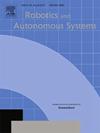双边约束条件下仿车移动机器人的效率优化路径规划算法
IF 4.3
2区 计算机科学
Q1 AUTOMATION & CONTROL SYSTEMS
引用次数: 0
摘要
在移动机器人路径规划领域,优化移动效率对于提高操作生产率至关重要。提出了一种优化机动效率的路径规划算法。该算法生成自由路径并利用拐点进行分割,在运动约束条件下利用杜宾曲线和仿线曲线进行路径平滑。考虑转弯过程中速度损失和行驶距离等动态变量的评价函数,选择最优的移动效率路径。实验结果表明,长度最短的路径并不总是最有效的。与Hybrid A*算法的对比分析表明,该算法能够在各种约束环境中生成平滑路径,从而增强机器人的移动性。在自行研制的三轮移动机器人上进行了验证实验,验证了所提路径的有效性。这种效率优化的路径规划算法在具有双边界约束和复杂拐角配置的工厂等环境中具有实际应用价值,提供节省时间的轨迹以提高机器人的整体运行效率。本文章由计算机程序翻译,如有差异,请以英文原文为准。
Efficiency-optimized path planning algorithm for car-like mobile robots in bilateral constraint corridor environments
In the field of mobile robot path planning, optimizing mobility efficiency is paramount for enhancing operational productivity. This paper presents a novel path planning algorithm designed to optimize mobility efficiency. The algorithm generates free paths and employs turning points for segmentation, while Dubins and clothoid curves are utilized for path smoothing within kinematic constraints. An evaluation function, considering dynamic variables like velocity loss and distance traveled during turning, selects the optimal path for mobility efficiency. Experimental results reveal that the shortest path in length is not always the most efficient. Comparative analysis with the Hybrid A* algorithm showcases the proposed algorithm’s ability to generate smooth paths across various constraint environments, thereby enhancing robot mobility. Validation experiments on a custom-developed three-wheeled mobile robot confirm the effectiveness of the derived paths. This efficiency-optimized path planning algorithm finds practical application in settings such as factories with dual-boundary constraints and intricate corner configurations, offering time-saving trajectories to bolster overall robot operational efficacy.
求助全文
通过发布文献求助,成功后即可免费获取论文全文。
去求助
来源期刊

Robotics and Autonomous Systems
工程技术-机器人学
CiteScore
9.00
自引率
7.00%
发文量
164
审稿时长
4.5 months
期刊介绍:
Robotics and Autonomous Systems will carry articles describing fundamental developments in the field of robotics, with special emphasis on autonomous systems. An important goal of this journal is to extend the state of the art in both symbolic and sensory based robot control and learning in the context of autonomous systems.
Robotics and Autonomous Systems will carry articles on the theoretical, computational and experimental aspects of autonomous systems, or modules of such systems.
 求助内容:
求助内容: 应助结果提醒方式:
应助结果提醒方式:


